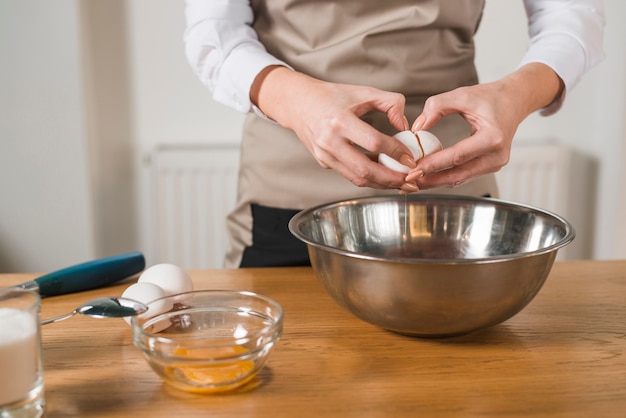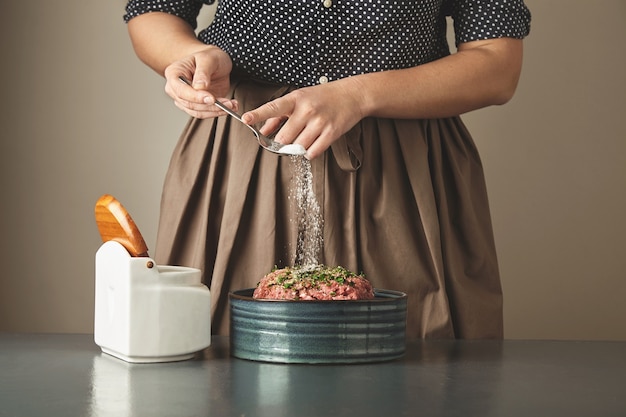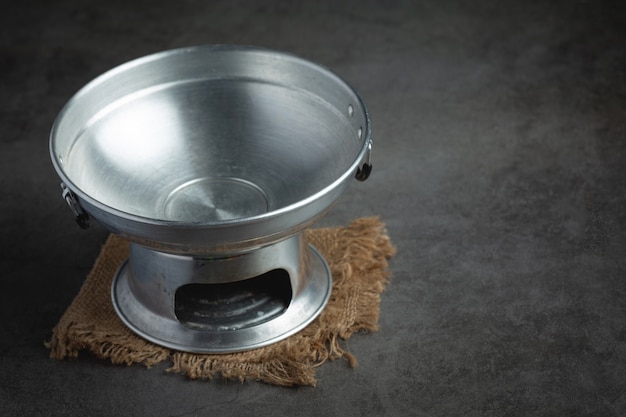Let's talk stainless steel. We all know that sleek, durable surface is a mainstay in most kitchens, but honestly, it can be a bit of a pain to work with. I've been there – staring at a stubborn, burnt-on mess on my pan, wondering how it got there in the first place. But I've also had those moments of pure joy when a perfectly seared steak slides effortlessly off my pan, leaving behind not a speck of food. Stainless steel is a bit of a two-faced friend, but with the right approach, you can master the art of cooking with it.
(Part 1) Understanding the Basics

First things first, let's understand why stainless steel is such a popular choice for cooking. It's known for its durability, even heat distribution, and resistance to rust. It's also relatively easy to clean, although, as I mentioned, it can be a bit of a diva when it comes to burnt food.
The Science Behind Stainless Steel
Stainless steel isn't just some fancy name. It's a specific blend of metals that gives it those fantastic properties. It's made up of iron, chromium, and nickel. The chromium is the key player here – it's the reason stainless steel is, well, stainless. It forms a protective layer on the surface that prevents rust from forming. The nickel contributes to the steel's resistance to corrosion and helps it withstand high temperatures. This combination makes it an ideal material for cookware, especially when you're dealing with high heat and acidic ingredients.
Types of stainless steel cookware
You'll find different grades of stainless steel used for cookware, each with its own unique characteristics. The most common ones you'll encounter are:
- 18/8 stainless steel: This is the most common type you'll find in kitchens. It boasts a 18% chromium and 8% nickel content. This combination makes it super durable, resistant to rust, and good for even heat distribution. It's a reliable choice for everyday cooking.
- 18/10 stainless steel: This grade has a slightly higher nickel content (10%), which gives it greater resistance to corrosion and staining. It's often used for high-end cookware because it's incredibly smooth and easy to clean. You'll notice a difference in its sleek, almost mirror-like finish.
- Tri-ply stainless steel: These pans are made with three layers: a stainless steel exterior and interior, and an aluminum core sandwiched between them. The aluminum core is the secret here. It helps distribute heat more evenly and quickly, making it great for delicate cooking. It's a bit like a turbocharged version of stainless steel.
- Copper-bottom stainless steel: These pans combine the durability and heat resistance of stainless steel with the fast-heating capabilities of copper. They're excellent for achieving consistent heat and precise control. Think of it as the best of both worlds.
(Part 2) Learning the Ropes: Essential Tips for Success

Now that you're a bit more familiar with the ins and outs of stainless steel, let's dive into some essential tips and tricks to make your cooking life easier. Remember, practice makes perfect, and these tips will help you master the art of cooking with this versatile material.
Tip 1: Pre-heating is Key
It might sound obvious, but pre-heating your stainless steel cookware is essential for achieving perfect results. Think of it like getting your car engine warmed up before hitting the road. Pre-heating your pan allows the heat to distribute evenly and helps prevent food from sticking. You'll get those beautiful sear marks on your steaks and get your crispy pan-fried vegetables just right. It's the foundation for delicious results.
Tip 2: The Right Oil Matters
Just as important as preheating is choosing the right oil for the job. I always go for oils with a high smoke point, like avocado oil or grapeseed oil. These oils can handle high temperatures without burning or breaking down, which can ruin the flavor of your food. You want an oil that will enhance your dish, not detract from it.
Tip 3: Patience is Your Friend
You've pre-heated your pan, added your oil, and are ready to cook. Now, resist the urge to stir or flip your food too soon. Let it cook undisturbed for a bit. You're aiming for a nice crust or sear, and constant movement will only prevent that from happening. Just trust the process, and you'll be rewarded with delicious results. Patience is a virtue in the kitchen.
(Part 3) Tackling the Challenges: Burnt Food and Other Nightmares

We've all been there. You're happily cooking away, and suddenly, a plume of smoke fills the kitchen, and you're left with a burnt-on mess that seems impossible to clean. Don't despair! Here are some tried-and-true methods to deal with those cooking disasters:
Dealing with Burnt Food
Burnt-on food is the bane of many stainless steel cookware users. But before you give up and reach for the SOS pad, try these tricks:
Method 1: The Baking Soda Soak
This is my go-to method. Fill your pan with enough water to cover the burnt food, add a generous amount of baking soda, and bring it to a boil. Let it simmer for a few minutes, and you'll find that most of the burnt food will loosen up and come off easily. Use a wooden spoon to gently scrape off any stubborn bits. The baking soda works its magic by breaking down the burnt food, making it easier to remove. It's a gentle, yet effective solution.
Method 2: The Vinegar Soak
White vinegar is a natural cleaning agent, and it works wonders for stubborn stains. Fill your pan with equal parts water and white vinegar, bring it to a simmer, and let it sit for a few minutes. Then, scrub the pan with a non-abrasive sponge or a soft cloth. Be careful not to scratch the surface. Vinegar's acidity helps to break down the burnt-on food, making it easier to clean. It's a good option for those who prefer a more natural approach.
Cleaning Tips for Stainless Steel
While we're on the subject of cleaning, here are a few additional tips to keep your stainless steel cookware looking shiny and new:
- Avoid harsh cleaners: Harsh chemicals can damage the finish of your stainless steel, so stick to mild dish soap and a soft cloth or sponge for everyday cleaning.
- Hand-washing is often best: While some stainless steel cookware is dishwasher safe, it's generally best to hand-wash it to preserve its finish. This also gives you a chance to inspect for any burnt-on food that needs a bit of extra attention. Hand-washing allows you to be more attentive to the cleaning process.
- Dry thoroughly: After cleaning, dry your stainless steel cookware thoroughly with a clean cloth. Water spots can leave a dull film on the surface, and you want to keep that shine alive.
- Avoid using steel wool or abrasive pads: These can scratch the surface of your stainless steel, causing it to lose its luster and become more susceptible to rust. It's all about protecting that beautiful finish.
(Part 4) The Joy of Cooking: A culinary journey with Stainless Steel
Now that you've got the basics down, let's explore the world of cooking with stainless steel. It's truly a versatile material that can handle anything from searing a steak to simmering a stew. It's a blank canvas for culinary creativity.
Searing Perfection: The Art of the Sear
One of the things I love most about stainless steel is how well it sears food. Get that pan blazing hot, add your meat or vegetables, and let those beautiful sear marks form. For a perfectly seared steak, make sure the pan is piping hot, and only flip it once. You're looking for a beautiful crust on the outside and juicy, pink perfection on the inside. It's a symphony of flavor and texture.
From Sauteing to Simmering: Mastering the Versatile Pan
stainless steel pans are also excellent for sauteing vegetables, making sauces, and simmering soups and stews. The even heat distribution ensures that your food cooks evenly, and the durability of the material means you can use it for high-heat cooking without worrying about it warping or bending. It's a workhorse in the kitchen, able to handle a variety of tasks.
Embracing the "Stick" Factor: Cooking with a Little Help
We've talked about preventing sticking, but sometimes it happens. Don't be afraid to use a bit of butter or oil to help prevent your food from sticking. Just add a little bit to the pan after it's preheated, and it'll create a protective layer that will help your food slide off easily. A little bit of lubrication can go a long way in preventing those frustrating sticking situations.
(Part 5) Beyond the Basics: Advanced Tips and Tricks
Now that you've got the foundation down, let's delve into some more advanced tips and tricks that will take your stainless steel cooking to the next level. These little secrets will help you unlock the full potential of your cookware.
Tip 4: The Art of the "Deglaze"
This is one of my favorite tricks for creating flavorful sauces. After searing your meat or vegetables, you're left with some delicious browned bits stuck to the bottom of the pan. Instead of scraping them away, add a bit of wine, broth, or water, and scrape those bits loose. The result is a rich, flavorful sauce that elevates your dish to new heights. It's a simple technique that can make a world of difference.
Tip 5: The Power of the "Steam"
Stainless steel is great for steaming vegetables. It's a healthy and delicious way to cook them. Just add a little bit of water to the bottom of a stainless steel pot, place a steamer basket inside, and add your vegetables. Cover the pot and let the steam do its magic. You'll get perfectly cooked vegetables with a vibrant flavor and a beautiful crunch. It's a gentle and flavorful way to prepare vegetables.
Tip 6: The Importance of "Seasoning"
Seasoning your stainless steel cookware is a bit like oiling a wooden cutting board. It creates a non-stick layer that helps prevent food from sticking and makes cleaning easier. To season your pan, simply heat it over medium heat, add a thin layer of oil, and let it heat for a few minutes. Then, wipe out the excess oil with a clean cloth. Repeat this process a few times, and you'll have a well-seasoned pan that will last for years to come. It's a simple step that can significantly improve your cooking experience.
(Part 6) Exploring the Stainless Steel World: A Culinary Journey
Now, let's talk about some of the amazing things you can cook with your stainless steel cookware. From savory dishes to decadent desserts, the possibilities are endless. It's a gateway to a world of culinary adventures.
The Savory Side: A Stainless Steel Feast
We've talked about searing steaks, but stainless steel is perfect for cooking a whole range of savory dishes. It's a versatile material that can handle any savory challenge.
- pan-seared chicken: Crispy on the outside, juicy on the inside, pan-seared chicken is a classic that's always a winner. Use a well-seasoned pan to achieve that golden-brown crust.
- Sautéed vegetables: Stainless steel is perfect for sauteing vegetables, from simple side dishes to complex stir-fries. The even heat distribution helps the vegetables cook evenly and retain their vibrant colors.
- Slow-cooked stews and soups: Stainless steel pots are great for simmering soups and stews for hours on end. They can handle the heat and hold their shape, ensuring that your dish cooks evenly and doesn't stick to the bottom of the pot.
The Sweet Side: Desserts that Shine
You might not think of stainless steel for desserts, but it's a surprisingly versatile material for baking and preparing sweet treats. It can handle the sweet side of cooking just as well.
- Caramelized apples: The even heat distribution of stainless steel pans makes them ideal for caramelizing apples, creating a sweet and sticky treat that's perfect for topping desserts or enjoying on its own.
- Custard and puddings: Stainless steel pots are great for making custards and puddings. They're easy to clean, and the even heat distribution helps prevent the custard from curdling or burning.
- Churros: For a fun and delicious treat, try making churros in a stainless steel pot. The deep, even heat helps them cook evenly and achieve that crispy exterior and soft, doughy interior.
(Part 7) Maintaining Your Stainless Steel: Keeping it in Tip-Top Shape
Now that you've mastered the art of cooking with stainless steel, it's time to learn how to keep your cookware in top shape for years to come. Proper care and maintenance are key to maximizing its lifespan.
Caring for Your Stainless Steel: A Guide to Longevity
- Avoid harsh abrasives: As we mentioned earlier, harsh cleaners and abrasive pads can scratch the surface of your stainless steel. Stick to mild dish soap and a soft sponge or cloth for everyday cleaning.
- Hand-wash whenever possible: While some stainless steel cookware is dishwasher safe, it's best to hand-wash it to prevent scratches and damage. This allows you to inspect for any burnt-on food and give it a gentle scrub if needed.
- Dry thoroughly: After cleaning your stainless steel cookware, dry it completely with a clean cloth. Water spots can leave a dull film on the surface, so you want to ensure it's completely dry.
- Store properly: Store your stainless steel cookware in a dry, cool place, preferably in a drawer or cupboard. Avoid stacking them on top of each other, as this can create scratches.
- Don't overheat: While stainless steel is durable, it can still be damaged by extreme heat. Avoid leaving an empty pan on the stovetop for too long, as this can cause warping.
(Part 8) Investing Wisely: Choosing the Right Stainless Steel Cookware
When it comes to investing in stainless steel cookware, you have a lot of options. Here are a few things to consider when making your choice. It's an investment that will last for years to come.
Factors to Consider When Buying Stainless Steel Cookware
- Quality: Look for cookware made from high-quality stainless steel, preferably 18/8 or 18/10. This will ensure durability, even heat distribution, and resistance to rust and corrosion.
- Construction: Pay attention to the construction of the cookware. Tri-ply stainless steel, with its aluminum core, is great for even heat distribution. Copper-bottom stainless steel offers fast heating and precise control.
- Weight and Balance: Choose cookware that is comfortable to hold and use. Heavy, well-balanced pots and pans are easier to maneuver and control.
- Features: Consider what features you need, such as lids, handles, and sizes. Some cookware sets come with a variety of pieces to meet all your cooking needs.
- Warranty: Look for cookware with a good warranty. This provides peace of mind and assurance that your investment is protected.
(Part 9) FAQs: Your Stainless Steel Questions Answered
You've learned a lot about stainless steel cooking, but you may still have some burning questions. Here are some frequently asked questions and their answers.
1. Is it really necessary to pre-heat a stainless steel pan?
Absolutely! Pre-heating your pan allows the heat to distribute evenly, preventing sticking and creating a beautiful sear on your food. It's the first step towards achieving perfect results.
2. How do I know if my stainless steel cookware is safe?
Look for cookware made from high-quality stainless steel, free of harmful chemicals and toxins. You can also check for certifications from reputable organizations, which ensure that the cookware meets safety standards.
3. Can I use stainless steel cookware on an induction stovetop?
Not all stainless steel cookware is compatible with induction stovetops. To use stainless steel on an induction cooktop, it must have a magnetic base. Look for cookware that is specifically labeled as induction compatible.
4. What's the best way to care for my stainless steel cookware?
Hand-wash it gently with mild dish soap and a soft sponge or cloth. Avoid harsh chemicals and abrasive pads. Dry it thoroughly after cleaning to prevent water spots.
5. How do I know when my stainless steel cookware is seasoned properly?
A properly seasoned stainless steel pan will have a thin, non-stick layer. You'll notice that food doesn't stick to the pan as easily, and cleaning becomes a breeze. If you're not sure if your pan is seasoned properly, repeat the seasoning process a few times to build up that protective layer.
There you have it, a comprehensive guide to mastering the art of stainless steel cooking. It's a journey that starts with understanding the basics, learning from experience, and embracing the challenges. With the right approach, you'll be a pro in no time, and you'll be able to create delicious dishes that will impress even the most discerning palates.
Everyone is watching

Prime Rib Roast Cooking Time Chart: Per Pound Guide
Cooking TipsPrime rib roast. Just the name conjures images of lavish dinners, crackling fires, and hearty laughter. It’s ...

How Long to Bake Potatoes in the Oven (Perfect Every Time)
Cooking TipsBaked potatoes are a staple in my kitchen. They're incredibly versatile, delicious, and surprisingly easy to m...

Perfect Rice Every Time: The Ultimate Guide to Cooking Rice
Cooking TipsAs a self-proclaimed foodie, I've always been a bit obsessed with rice. It's the foundation of countless cuisi...

The Ultimate Guide to Cooking Asparagus: Tips, Techniques, and Recipes
Cooking TipsAsparagus. The mere mention of this spring delicacy conjures up images of vibrant green spears, crisp and burs...

Ultimate Guide to Cooking the Perfect Thanksgiving Turkey
Cooking TipsThanksgiving. Just the word conjures up images of overflowing tables laden with delicious food, the scent of r...
